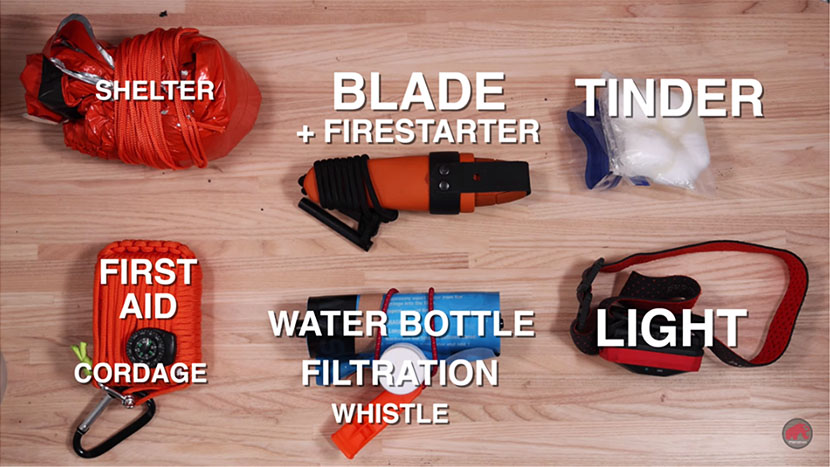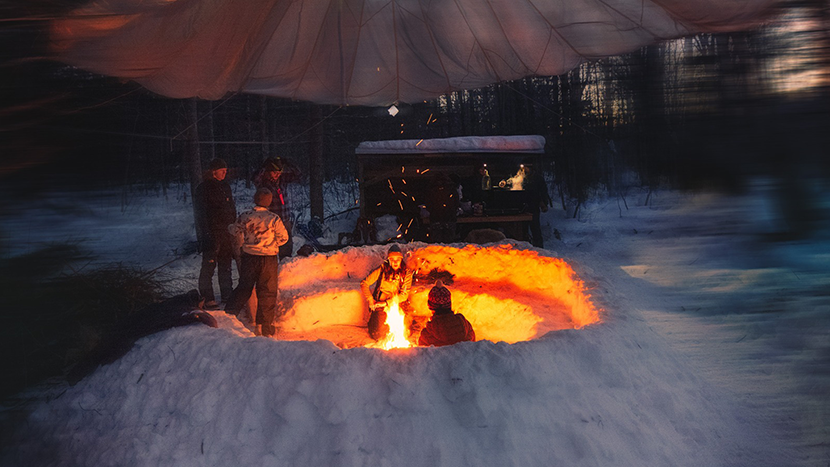Survival Kit Essentials
In the blink of an eye the unexpected could happen, and you might find yourself in a survival situation. Though you can never know when or where, you can be prepared for the worst at any time by always carrying a survival kit. There are many things that you can add to your survival kit to make surviving an unknown period of time more bearable, but basically, you need to make sure you are covering the rule of 3’s for survival! Here we have broken down the 10 essentials for your survival kit!
Before we get into it, this is not what we would consider a pack for a hiking or camping trip where you would also want to include food and water rations – and a lot more items – but the ABSOLUTE ESSENTIALS to survive on your own in the wilderness. We will start with an advanced breakdown of the best survival kit, then mention the bare minimum “mini survival kit” at the end.
Blades
A blade is absolutely key to surviving in the wilderness. Whether you need to cut rope, break down wood into smaller pieces to build a fire, cut bark off trees, among other things, having a good knife will be a life saver – literally.
Ideally you will have a good bushcraft knife, but a smaller blade could do. If you have a larger kit you could also consider a small hatchet and a saw. For more on knives, check the video below:
Shelter
Shelter is actually the first thing you should take care of in a survival situation. You need shelter to be able to stay dry and warm, the rest can wait. We recommend packing an emergency tent and emergency blanket as a minimum. If you have more space you could add in a tarp, and even a small hammock. The main thing is that you have something that is waterproof to sleep in overnight.
Fire (Ways to Make a Fire)
Fire will help you stay warm, give you light, let you boil water, and can be used to signal for help. So, having a fire starting kit is crucial. Generally you want to have at least three ways to start a fire. Some options are:
- Matches (ideally waterproof)
- Ferro rod/magnesium rod
- Survival matches
- Lighter
- A battery and steel wool
You should also have some tinder, which is the easy-to-light materials to help get your fire started. Some options for tinder are
- A bag of dryer lint
- Cotton balls soaked in vaseline
- Jute
- Paracord
With this in your kit you will have a much better time starting a fire, which will help you out a lot!
Cordage
Rope will be your best friend in a survival situation. You will need it to help set up your shelter, it can be used for tinder, and can even help you carry more wood at once, and more. We recommend having good paracord for a survival situation, or you could consider investing a bit more in “survival rope.” Survival rope has various smaller ropes inside it, one for fishing, jute for fire starter, etc. A great trick to always have plenty of rope with you is by making a survival bracelet.
Water (Ways to Purify Drinking Water)
You can last three days without water, but it is definitely not pleasant and should be your priority after shelter and fire. You should always have a good sized water bottle, and various ways to make water safe for drinking. You can buy filtration straws, filtration kits, or iodine pills. It is always best to have a few ways to clean your drinking water.
Light Source
Having light is important, especially if you are in a part of the world, or season, where the sun sets early. You should always, as a minimum, have a headlamp to use. We also recommend a small lantern, and maybe a chemical light (kind of like a fancy glowstick) and/or a candle light.
Signalling
Your main priority, after staying warm and dry, should be getting found as soon as possible. Most people know that it is best to stay put and wait for someone to find you, and they will be able to find you much faster if you can signal for help. The minimum that everyone should have when going outdoors is a whistle. For more advanced kits you can also get signal flares, beacons (especially for boats), and even signaling mirrors.
If you have a fire started, you can also create a signal fire which will produce lots of smoke. You can make a signal fire by burning green materials, but do not pile them onto your main fire! Instead, find a branch with a nice “Y” in it. Collect pine needles or other green leaves and pile them up on your stick. You can then hold this up over your main fire to produce smoke without putting your main fire out.
First aid kit
A basic kit with bandages, tape, gauze, and alcohol will do, but it is a good idea to buy a kit that has all the essentials for dealing with any cuts and injuries until you are found and can be treated properly.
Bag
Once you have your kit together you will want to make sure it is in a good bag. Ideally you want something durable and waterproof, though you can always put your kit into a dry bag and put that in your backpack later. Rob recommends this bag as an example.
The Knowledge on How to Use Your Survival Kit
Having a good survival kit is the first step to surviving an emergency situation, but having the knowledge and practice on how to use all of your gear is also really important. For this, we first recommend Rob and Haley’s book: Mother Nature is Not Trying to Kill You. To get some practice and put your new survival kit to use, you could join us on one of our winter survival courses! Sign up to our newsletter here so you never miss an update!
Mini Survival kit absolute essentials
Sometimes you do not have a lot of space for a whole survival kit, or you want a secondary kit that is a bit smaller. In that case, the absolute essentials look like this:

The essentials for a mini survival kit are:
- Emergency tent
- Blade that is also a fire starter (has a ferro rod included)
- Tinder
- Small first aid kit
- Cordage
- Water bottle and filtration system
- Headlamp
Though we hope to never be in a survival situation, being prepared is never a bad thing, and it could actually make the difference between life and death if you find yourself in a remote area for a long period of time. With that said, we hope that potential dangers of the outdoors don’t dissuade you from getting outside and reconnecting with nature! For more, don’t forget to check out our other survival skills articles!


